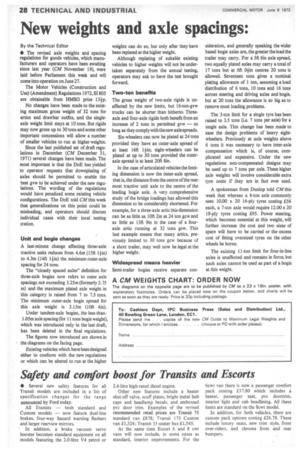New weights and axle spacings:
Page 30

If you've noticed an error in this article please click here to report it so we can fix it.
By the Technical Editor • The revised axle weights and spacing regulations for goods vehicles, which manufacturers and operators have been awaiting since last year (CM November 19), were laid before Parliament this week and will come into operation on June 27.
The Motor Vehicles (Construction and Use) (Amendment) Regulations 1972, SI 805 are obtainable from HMSO price 131-p.
No changes have been made to the existing maximum gross weight of 32 tons for artics and drawbar outfits, and the singleaxle weight limit stays at 10 tons. But rigids may now gross up to 30 tons and some other important concessions will allow a number of smaller vehicles to run at higher weights.
Since the last published set of draft regulations in December (CM December 31, 1971) several changes have been made. The most important is that the DoE has yielded to operator requests that downplating of axles should be permitted to enable the best gvw to be achieved under the new regulations. The wording of the regulations would have penalized some existing vehicle configurations. The DoE told CM this week that generalizations on this point could be misleading, and operators should discuss individual cases with their local testing station.
Unit and bogie changes
A last-minute change affecting three-axle tractive units reduces from 4.6m (15ft 14-in) to 4.3m (14ft lfin) the minimum outer-axle spacing for 24 tons.
The "closely spaced axles" definition for three-axle bogies now refers to outer axle spacings not exceeding 3.25m (formerly 2.75 m) and the maximum plated axle weight in this category is raised from 7 to 7.5 tons. The minimum outer-axle bogie spread for this axle weight is 3.15m (loft '4in).
Under tandem-axle bogies, the less-than1.05m axle spacing (for 11 tons bogie weight), which was introduced only in the last draft, has been deleted in the final regulations.
The figures now introduced are shown in the diagrams on the facing page.
Existing vehicles which have been designed either to conform with the new regulations or which can be altered to run at the higher weights can do so, but only after they have been replated at the higher weight.
Although replating of suitable existing vehicles to higher weights will not be undertaken separately from the annual testing, operators may ask to have the test brought forward.
Two-ton benefits
The gross weight of two-axle rigids is unaffected by the new limits, but 16-ton-gvw trucks can be shorter than hitherto. Threeaxle and four-axle rigids both benefit from an increase of 2 tons in permitted gvw — so long as they comply with the new axle spreads.
Six-wheelers can now be plated at 24 tons provided they have an outer-axle spread of at least 1611 1 fin; eight-wheelers can be plated at up to 30 tons provided the outeraxle spread is at least 20ft 8in.
In the case of articulated vehicles the limiting dimension is now the inner-axle spread, that is, the distance from the centre of the rearmost tractive unit axle to the centre of the leading bogie axle. A very comprehensive study of the bridge loadings has allowed this dimension to be considerably shortened. For example, for a three-axle attic this dimension can be as little as 10ft 2in at 24 ton gcw and as little as 13ft 9in in the case of a fouraxle artic running at 32 tons gcw. This last example means that many artics, previously, limited to 30 tons gcw because of a short trailer, may well now be legal at the higher weight.
Widespread means heavier Semi-trailer bogies receive separate con sideration, and generally speaking the wider based bogie axles are, the greater the load the trailer may carry. For a 3ft 6in axle spread, two equally plated axles may carry a total of 17 tons but at 6ft Ofin centres 20 tons is allowed. Seventeen tons gives a nominal plating allowance of 1 ton, assuming a load distribution of 6 tons, 10 tons and 16 tons across steering and driving axles and bogie, but at 20 tons the allowance is so big as to remove most loading problems.
The 3-ton limit for a single tyre has been raised to 3.5 tons (i.e. 7 tons per axle) for a single axle. This change has been made to ease the design problems of heavy eightwheelers. Previously at axle weights above 6 tons it was necessary to have inter-axle compensation which is, of course, complicated and expensive. Under the new regulations non-compensated designs may be used up to 7 tons per axle. These higher axle weights will involve considerable extra tyre costs if they are in fact ever used.
A spokesman from Dunlop told CM this week that whereas a 6-ton axle commonly uses 10.00 x 20 16-ply tyres costing /56 each, a 7-ton axle would require 12.00 x 20 18-ply tyres costing £95. Power steering, which becomes essential at this weight, will further increase the cost and two sizes of spare will have to be carried or the excess cost of fitting oversized tyres on the other wheels be borne.
The existing 11-ton limit for four-in-line axles is unaffected and remains in force, but such axles cannot be used as part of a bogie at this weight.




































































































